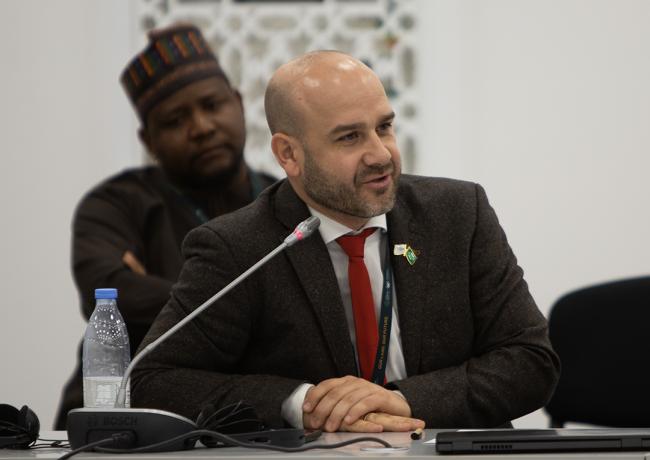About
The World Drought Atlas, launched during UNCCD COP 16, is a timely and important policymaker tool which illustrates the complex, systemic nature of drought, providing the latest science and policy solutions to underpin water resilience strategies that are proactive and inclusive.
The disruptive potential of drought impacts goes beyond agriculture and water supply, to also impact energy supply, inland navigation, and ecosystems, among other sectors. This event presented the World Drought Atlas, jointly developed by the European Commission and the UNCCD, as a tool for policymakers to access the latest science on managing drought risks. It also includes case studies that illustrate the latest drought management solutions.
Tessa Maurer, CIMA Research Foundation, Italy, moderated the discussion.
Cristina de Avila, Directorate-General for Environment, European Commission, noted that the European Union (EU) is developing policies to inform a water resilience strategy. She stressed the importance of cooperation for such a strategy, not only between the public and private sectors, but also between affected and non-affected parties.
Maurer, presenting an overview of the Atlas, provided key insights. First, she noted that biodiversity is a factor that can mitigate drought. Second, she highlighted that drought events have spurred transboundary river basin agreements. Third, she noted the Atlas supports an ever-evolving response where there are different entry points to the problem, and where those entry points can help support each other.
Andrea Toreti, European Commission Joint Research Centre, said drought events are becoming more complex as they are compounded by heatwaves and occur more frequently. He explained that events such as the 2018 drought, which affected a large swathe of the Northern Hemisphere, have both short- and long-term ecosystem impacts, which in turn can trigger shocks to global markets, the real economy, and the financial system; therefore, economic policies should be designed for greater resilience.
Lauro Rossi, CIMA Research Foundation, pointed out that the cover of the Atlas features a photo of a reservoir in Europe, intentionally countering the stereotype that drought mainly affects agriculture in developing countries.
Roger Pulwarty, National Oceanic and Atmospheric Administration (NOAA), US, called for undertaking proactive responses even if not all the information is available, given that no system exists for forecasting multi-year drought.
Viola Otieno, African Union Commission (AUC), discussed how early warning systems (EWS) can be made more actionable. She noted the time lag between early warning and government action, explaining that governments may require time to pass legislation to enable action. She called for: moving from hazard-based to impact-based warnings that provide information about what people can do in response; moving from single-hazard warnings to take into account the compounding impacts of disaster; and coordinating across different sectors for response and recovery. She observed that half of all African countries do not have a drought strategy and called for addressing systemic root causes.
Valentin Aich, World Meteorological Organization (WMO) and Global Water Partnership (GWP), welcomed the Atlas as a tool that can show countries how drought should be understood—not as a “single-track” focus on agriculture, but as a complex disaster to be tackled on different fronts.
In response to a question about the scope for applying nature-based solutions (NBS) to alleviate drought, de Avila pointed to the EU’s Nature Restoration Law, which entered into force in 2024. She cautioned that data and information will be needed for robust assessments, and that achieving impact through NBS will take time, financing, and engagement with both the public and private sectors.
Patrick Augenstein, Intergovernmental Working Group on Drought, UNCCD, said the most powerful contribution of the Atlas is that it reframes drought, not as a natural phenomenon, but one that is connected to human practices. He noted that drought is in the UNCCD’s mandate, and that 70 countries already have national drought plans in place.
During a question-and-answer session, participants raised questions related to: what subnational actors can do in the absence of central government action; how the Atlas might serve as a platform to boost intersectoral and interdisciplinary coordination; and what would be the characteristics of a “good” coordination and anticipatory action on drought.
Aich responded that the UNCCD has convened regional Communities of Practice, in line with the Convention’s annexes that list signatories by region. He cautioned against the use of external consultants to write policy, as it takes time to understand the realities of each country.
Toreti linked action on drought to water management practices to develop a water-resilient future. He encouraged participants to work with the International Drought Resilience Alliance and the Integrated Drought Management Programme, as well as the recently-launched International Drought Resilience Observatory that was recently launched at the UNCCD’s 16th session of the Conference of the Parties (COP 16) in Riyadh.
Otieno drew attention to the AUC’s impending launch of a new Drought Early Warning and Monitoring Service.
Pulwarty commented that coordination across sectors should feature partnerships with academia and civil society, which are critical for building trust. He highlighted the importance of sharing risks and responsibilities, as well as demanding accountability from decision makers, including those at the local level.
Otieno explained that in 2024, the Southern African region received its largest-ever allocation for anticipatory action on drought; however, governments are managing competing priorities and do not necessarily prioritize anticipatory action. She called for designing anticipatory action in such a way that it reduces the burden on governments in the long run, noting that, “At the end of the day, all roads point to resilience building.”
Organizer: European Commission Joint Research Centre
Contact: info@cimafoundation.org
Website: https://joint-research-centre.ec.europa.eu/index_en
To receive free coverage of global environmental events delivered to your inbox, subscribe to the ENB Update newsletter.
All ENB photos are free to use with attribution. For UNCCD COP 15 Side Events, please use: Photo by IISD/ENB | Angeles Estrada Vigil





















